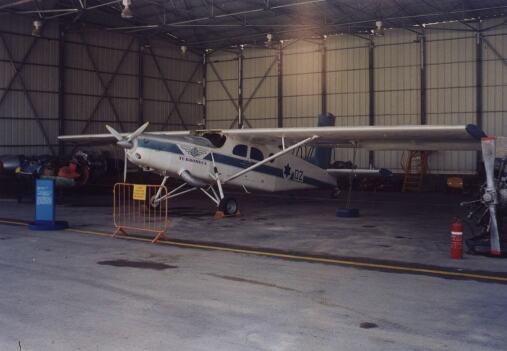Israeli Air Force Light Aircraft
Airspeed A.S. 65 Consul
The Airspeed Consul begun its life as the Airspeed Oxford, A twin engined monoplane wooden trainer which first flew on 19 June 1934.
The Oxford saw extensive service as a pilot and aircrew trainer in the British Commonwealth Air Training Plan during World War II, when it was
also used for medical use, radar calibration, communications as well as other roles. 161 aircraft were refurbished after the war for civilian use, these
being renamed the Consul.
October 1949 saw the formation of 141 Squadron, the IAF's multi-engined-flying school, in Ekron (Tel-Nof) AFB. 141 Squadron trained aircrew in flying,
navigation, radio operation, instrument flying and aerial gunnery and operated both the Avro Anson and a number of Consuls acquired from
their British operator in 1949. The Consuls were primary tasked with training pilots for the transport and de Havilland Mosquito
fighter bomber fleets. In 1950 the IAF flight school moved to Sirkin AFB and Consul operations continued from there.
As Consuls were also fitted with 6 passenger seats, the aircraft were occasionaly used as VIP transports as well. The most notable occasion
was in June 1949 when a Consul carried David Ben-Gurion, Israel's first prime minister, and his entourage on tour of southern Israel.
The aircraft initial poor mechanical state, coupled with the poor quality of IAF maintenance and the aircraft's
tough handling characteristics, caused a quick depletion in IAF Consul numbers. 14 aircraft were still operational in December 1952, but only
3 had remained servicable by April 1957. The type was retired in sometime during the same year.
Specification: Airspeed A.S. 65 Consul
Type: two crew, low-wing, pilot and aircrew monoplane trainer.
Powerplant: two Armstrong Siddeley Cheetah X.
Performance: cruising speed - 262km/h, max speed - 306km/h, rate of climb - 305m/min, service ceiling - 7,163m, range - 1,448km.
Weights: empty - 2,720kg, max takeoff - 3,740kg.
Dimensions: span - 16.3m, length - 10.8m, height - 3.1m.
Armament: none.
Pilatus PC-6A Turbo Porter

Turbo Porter at the IAF Museum, click to enlarge
One of the most successful aircraft of its class, the piston engined Pilatus PC-6 Porter featured a strong and reliable airframe, excellent short take off and landing (STOL) capability and excellent load-carrying capacity. A total of 50 Porters were built before production changed to the turboprop-powered PC-6A-H1, first flown on May 2nd 1961. Turbo Porters have enjoyed great success around the world and have been operated by various air arms, including those of Australia, Switzerland, Dubai, Indonesia, Iran, Oman and Sudan.
A single PC-6A Turbo Porter arrived in Israel in 1962 and was used by the 100th light transport squadron at Sde-Dov for utility, liaison and ambulance duties.
Another Turbo Porter was procured in 1968 after a crash disabled the first example.
The Turbo Porter was retired from service in 1973 and is currently on display at the IAF Museum in Hatzerim.
Specification: Pilatus PC-6A-H1
Type: STOL utility transport.
Powerplant: one Turbomeca Astazou IIE turboprop engine.
Performance: max speed - 280km/h, cruising speed - 213km/h, max range - 926km, service ceiling - 7,620m.
Weights: empty - 1,270kg, max take off - 2,800kg.
Dimensions: length - 11.00m, height - 3.20m, span - 15.87m.
Armament: none.
back to Inventory page
my email : skythe@iname.com
 back to the IDF/AF page
back to the IDF/AF page


 back to the IDF/AF page
back to the IDF/AF page